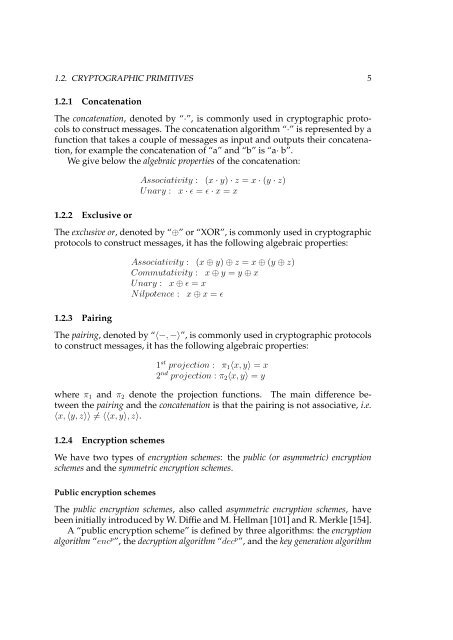Logical Analysis and Verification of Cryptographic Protocols - Loria
Logical Analysis and Verification of Cryptographic Protocols - Loria
Logical Analysis and Verification of Cryptographic Protocols - Loria
You also want an ePaper? Increase the reach of your titles
YUMPU automatically turns print PDFs into web optimized ePapers that Google loves.
1.2. CRYPTOGRAPHIC PRIMITIVES 5<br />
1.2.1 Concatenation<br />
The concatenation, denoted by “·”, is commonly used in cryptographic protocols<br />
to construct messages. The concatenation algorithm “·” is represented by a<br />
function that takes a couple <strong>of</strong> messages as input <strong>and</strong> outputs their concatenation,<br />
for example the concatenation <strong>of</strong> “a” <strong>and</strong> “b” is “a· b”.<br />
We give below the algebraic properties <strong>of</strong> the concatenation:<br />
1.2.2 Exclusive or<br />
Associativity : (x · y) · z = x · (y · z)<br />
Unary : x · ɛ = ɛ · x = x<br />
The exclusive or, denoted by “⊕” or “XOR”, is commonly used in cryptographic<br />
protocols to construct messages, it has the following algebraic properties:<br />
1.2.3 Pairing<br />
Associativity : (x ⊕ y) ⊕ z = x ⊕ (y ⊕ z)<br />
Commutativity : x ⊕ y = y ⊕ x<br />
Unary : x ⊕ ɛ = x<br />
Nilpotence : x ⊕ x = ɛ<br />
The pairing, denoted by “〈−, −〉”, is commonly used in cryptographic protocols<br />
to construct messages, it has the following algebraic properties:<br />
1 st projection : π1〈x, y〉 = x<br />
2 nd projection : π2〈x, y〉 = y<br />
where π1 <strong>and</strong> π2 denote the projection functions. The main difference between<br />
the pairing <strong>and</strong> the concatenation is that the pairing is not associative, i.e.<br />
〈x, 〈y, z〉〉 �= 〈〈x, y〉, z〉.<br />
1.2.4 Encryption schemes<br />
We have two types <strong>of</strong> encryption schemes: the public (or asymmetric) encryption<br />
schemes <strong>and</strong> the symmetric encryption schemes.<br />
Public encryption schemes<br />
The public encryption schemes, also called asymmetric encryption schemes, have<br />
been initially introduced by W. Diffie <strong>and</strong> M. Hellman [101] <strong>and</strong> R. Merkle [154].<br />
A “public encryption scheme” is defined by three algorithms: the encryption<br />
algorithm “enc p ”, the decryption algorithm “dec p ”, <strong>and</strong> the key generation algorithm
















